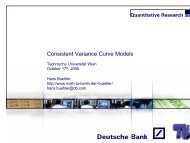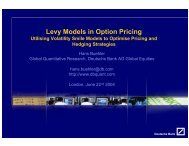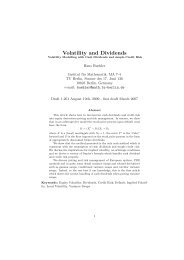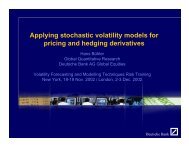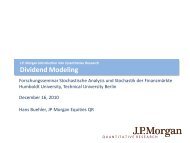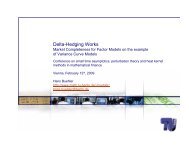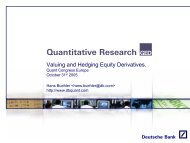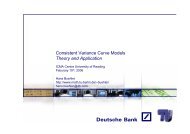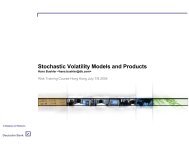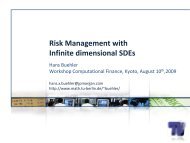Modeling Variance Swap Curves: Theory and ... - Hans Buehler
Modeling Variance Swap Curves: Theory and ... - Hans Buehler
Modeling Variance Swap Curves: Theory and ... - Hans Buehler
You also want an ePaper? Increase the reach of your titles
YUMPU automatically turns print PDFs into web optimized ePapers that Google loves.
Reference (apr02)<br />
<strong>Modeling</strong> <strong>Variance</strong> <strong>Swap</strong> <strong>Curves</strong>:<br />
<strong>Theory</strong> <strong>and</strong> Application<br />
Petit Dejeuner de la Finance, Paris, Feburary 21 st , 2006<br />
<strong>Hans</strong> <strong>Buehler</strong><br />
http://www.math.tu-berlin.de/~buehler/<br />
hans.buehler@db.com
GME Quantitative Products Analytics<br />
Consistent <strong>Variance</strong> Curve Models<br />
Outline<br />
� Introduction to Realized <strong>Variance</strong> markets<br />
� <strong>Variance</strong> Curve Models<br />
� Examples <strong>and</strong> the impact of using multi-factor models<br />
� Fitting the market<br />
� Outlook<br />
2 Reference (apr02)
GME Quantitative Products Analytics<br />
Realized <strong>Variance</strong><br />
Trading volatility<br />
3 Reference (apr02)
GME Quantitative Products Analytics<br />
Realized <strong>Variance</strong><br />
Introduction<br />
� Equity market investors are interested in “trading volatility”<br />
4 Reference (apr02)<br />
– Speculation<br />
– Hedging<br />
- Ad-hoc “vega-hedging” against moves in volatility if Black&Scholes-type pricing<br />
models are used<br />
� Traditionally, both have been implemented using European options.<br />
� But European options are not very sensitive to volatility once spot<br />
moves away from the strike.<br />
– Why don’t we trade volatility (or at least variance) directly?
GME Quantitative Products Analytics<br />
Realized <strong>Variance</strong><br />
Introduction<br />
� The realized variance of a stock price process S=(S t) t over business<br />
days 0=t 0< …
GME Quantitative Products Analytics<br />
Realized <strong>Variance</strong><br />
Introduction<br />
� That also makes sense from a “stochastic analysis” viewpoint:<br />
If T is fixed but n↑∞, then we see that<br />
2<br />
n ⎛ S ⎞ t<br />
log ∑ ⎜<br />
t<br />
S<br />
≈ log ⎟<br />
T ⎜ ⎟<br />
i= 1 ⎝ Stt<br />
−1<br />
⎠<br />
6 Reference (apr02)<br />
by definition of the quadratic variation.<br />
– This is also true if S has a drift <strong>and</strong> potentially jumps, hence the zero-mean<br />
assumption is justified in the limit.<br />
� In the forthcoming discussion, we will assume that realized variance<br />
is defined as quadratic variation.<br />
� The error is discussed in Barndorff-Nielsen et al (2004).
GME Quantitative Products Analytics<br />
Realized <strong>Variance</strong><br />
Assumptions<br />
� Assume that S is strictly positive, continuous, that it pays no dividends <strong>and</strong><br />
that the interest rates are zero. Hence, we may* write it on a stochastic base<br />
(Ω,P,F) as<br />
7 Reference (apr02)<br />
S<br />
t<br />
dX<br />
t<br />
( X − X )<br />
1<br />
– The one-dimensional Brownian motion B is adapted to the filtration F.<br />
– The short variance process ζ is a predictable, integrable <strong>and</strong> non-negative.<br />
– Deterministic rates <strong>and</strong> proportional dividends can be taken into account<br />
(forthcoming “Equity Hybrid Derivatives”, 2006)<br />
� Realized variance is then the non-negative quantity<br />
=<br />
* If additionally its quadratic variation is absolutely continuous w.r.t. λ.<br />
= exp 2<br />
t<br />
t<br />
ζ dB<br />
log S ζ ds<br />
T<br />
= T<br />
∫<br />
0<br />
t<br />
s<br />
t
GME Quantitative Products Analytics<br />
Realized <strong>Variance</strong><br />
<strong>Variance</strong> <strong>Swap</strong>s<br />
� The simplest product on realized variance is a variance swap.<br />
� A variance swap is just a forward on realized variance:<br />
8 Reference (apr02)<br />
– At maturity T it pays the realized variance occurred during the life of the<br />
contract (usually in exchange for a previously agreed fixed strike K).<br />
– The price V t (T) of a zero strike variance swap is just the expectation of the<br />
realized variance under an equivalent martingale measure:<br />
T<br />
V = ⎡<br />
t ( T ) : E<br />
⎢⎣ ∫ sds<br />
| Ft<br />
0 ζ<br />
– It can be hedged using a static position in a log-contract <strong>and</strong> delta-hedging<br />
with 1/St :<br />
T<br />
1 1 1<br />
2 ∫ tdt<br />
= ∫ d S = t<br />
S ∫ S<br />
ζ<br />
0<br />
T<br />
0<br />
2<br />
t<br />
T<br />
0<br />
t<br />
⎤<br />
⎥⎦<br />
dS<br />
t<br />
S<br />
− log<br />
S<br />
T<br />
0
GME Quantitative Products Analytics<br />
Realized <strong>Variance</strong><br />
Realized <strong>Variance</strong><br />
<strong>Variance</strong> <strong>Swap</strong>s<br />
.STOXX50E Realized <strong>Variance</strong> Hedge (90 days)<br />
45.0%<br />
40.0%<br />
35.0%<br />
30.0%<br />
25.0%<br />
20.0%<br />
15.0%<br />
10.0%<br />
5.0%<br />
9 Reference (apr02)<br />
Realized variance<br />
VS Hedge<br />
VS Hedge Approx<br />
VS Hedging Error<br />
0.0%<br />
05/92 05/93 05/94 05/95 05/96 05/97 05/98 05/99 05/00 05/01 05/02 05/03 05/04 05/05<br />
1.0%<br />
0.8%<br />
0.6%<br />
0.4%<br />
0.2%<br />
0.0%<br />
-0.2%<br />
-0.4%<br />
-0.6%<br />
-0.8%<br />
-1.0%<br />
Hedging Error (absolute)
GME Quantitative Products Analytics<br />
Realized <strong>Variance</strong><br />
<strong>Variance</strong> <strong>Swap</strong>s<br />
� The convex European log-payoff is usually approximated by a series<br />
of calls <strong>and</strong> puts,<br />
V<br />
� The formula probably contributes to the fact that variance swaps are<br />
now liquidly traded for all major indices.<br />
10 Reference (apr02)<br />
0<br />
( T )<br />
=<br />
=<br />
=<br />
T<br />
T<br />
⎡ 1<br />
2 E −<br />
⎤<br />
⎢⎣ ∫ ζ<br />
s dBs<br />
+ ∫ζ<br />
2 sds<br />
0<br />
0 ⎥⎦<br />
2 E[<br />
ST<br />
−1<br />
− log ST<br />
]<br />
⎧ 1 1<br />
∞ 1<br />
2⎨∫<br />
Put(<br />
T,<br />
K)<br />
dK +<br />
0 2 ∫1<br />
⎩ K<br />
K<br />
– An excellent reference is Demeterfi et al (1999).<br />
2<br />
Call(<br />
T,<br />
K)<br />
dK<br />
⎫<br />
⎬<br />
⎭
GME Quantitative Products Analytics<br />
Realized <strong>Variance</strong><br />
<strong>Variance</strong> <strong>Swap</strong>s ∫ T<br />
Prices are quoted in “volatility”<br />
Var<strong>Swap</strong> fair strike<br />
35<br />
30<br />
25<br />
20<br />
15<br />
10<br />
11 Reference (apr02)<br />
5<br />
<strong>Variance</strong> <strong>Swap</strong> Volatilities<br />
1<br />
.STOXX50E 04/01/2006<br />
.GDAXI 16/01/2006<br />
.N225 17/01/2006<br />
.SPX 20/01/2006<br />
T 0<br />
1<br />
ζ<br />
0<br />
0.0 0.5 1.0 1.5 2.0 2.5<br />
Years to maturity<br />
3.0 3.5 4.0 4.5 5.0<br />
s ds
GME Quantitative Products Analytics<br />
Realized <strong>Variance</strong><br />
<strong>Variance</strong> <strong>Swap</strong> Markets<br />
� In particular in the US, the variance swap market is very liquid.<br />
12 Reference (apr02)<br />
– Spread in terms of volatility is just 0.4 vol points, compared with 0.2 vol points for<br />
ATM European options.<br />
– STOXX50E around 0.5 versus 0.25 points<br />
– Bloomberg started quoting variance swaps Jan 06 – until now OTC.<br />
� VIX in the US<br />
– Volatility index on SPX realized variance<br />
– The VIX index states the floating one month variance swap price (“fixed-time-tomaturity”)<br />
– Future not very liquid due to problems in replication (constant roll-over of variance<br />
swaps involves rolling over of European options if position is hedged).
GME Quantitative Products Analytics<br />
Realized <strong>Variance</strong><br />
Beyond <strong>Variance</strong> <strong>Swap</strong>s<br />
� Since variance swaps are liquidly traded, there is no need to price them.<br />
� Similarly, we do not need particular models to price other recently revived<br />
payoffs (they can mostly also be replicated using “model-free” arguments):<br />
13 Reference (apr02)<br />
– Gamma swaps (or weighted variance swaps)<br />
– Conditional variance swaps<br />
1<br />
252<br />
S<br />
⎛<br />
n<br />
tt−1<br />
t<br />
∑ ⎜log<br />
n ⎜<br />
i= 1 S0<br />
St<br />
⎛<br />
⎜<br />
⎝<br />
S<br />
n<br />
t<br />
∑ 1 ≤ ≤ ⎜<br />
⎜<br />
L S U 252 log<br />
tt−1<br />
⎜<br />
i= 1<br />
St<br />
⎜<br />
⎝<br />
⎛<br />
⎝<br />
t<br />
t−1<br />
n t−1<br />
S<br />
t<br />
2<br />
⎞<br />
⎟<br />
⎠<br />
2<br />
⎞<br />
⎟ − K<br />
⎟<br />
⎠<br />
2<br />
⎞<br />
⎟<br />
⎟<br />
⎠
GME Quantitative Products Analytics<br />
Realized <strong>Variance</strong><br />
Beyond <strong>Variance</strong> <strong>Swap</strong>s<br />
� But what about more complex products:<br />
14 Reference (apr02)<br />
– European options on realized variance such as plain calls<br />
⎛<br />
⎜<br />
⎝<br />
– Options on <strong>Variance</strong> <strong>Swap</strong>s<br />
( V T , T ) − kV ( T , T ) )<br />
t ( R<br />
0<br />
1<br />
T<br />
∫<br />
T<br />
ζ ds − K<br />
0<br />
+<br />
⎞<br />
⎟<br />
⎠<br />
– But also forward started options on the stock (cf. Bergomi 2005)<br />
⎛<br />
⎜<br />
⎝<br />
S<br />
T<br />
2<br />
S<br />
T<br />
1<br />
R<br />
+<br />
T<br />
s<br />
− T<br />
R<br />
2<br />
= ⎡<br />
⎢⎣ ∫ T<br />
V t ( TR<br />
, T ) : E ζ<br />
tdt<br />
| F<br />
TR<br />
+<br />
+<br />
⎛ T ⎛ 2<br />
T2<br />
⎞<br />
⎞ ⎞<br />
− k ⎟ = ⎜exp⎜<br />
− ⎟ − ⎟<br />
⎠ ⎜ ⎜ ∫ ζ dB 1<br />
s s 2 ∫ζ<br />
sds<br />
k<br />
⎟ ⎟<br />
⎝ ⎝ T1<br />
T1<br />
⎠ ⎠<br />
T<br />
R<br />
⎤<br />
⎥⎦
GME Quantitative Products Analytics<br />
Realized <strong>Variance</strong><br />
Beyond <strong>Variance</strong> <strong>Swap</strong>s<br />
� Very popular: bets on volatilty of volatility (VolOfVol) in the form of<br />
straddles on realized variance:<br />
15 Reference (apr02)<br />
– The strike K is the variance swap strike (“ATM straddle”)<br />
– Initial “vol-delta” is zero, but high gamma.<br />
� Also sought after: capped calls<br />
T<br />
∫ sds<br />
− ζ<br />
0<br />
K<br />
⎧<br />
T<br />
2<br />
min⎨( 20%<br />
+ K)<br />
, ⎜<br />
⎛ −<br />
⎩<br />
⎝∫<br />
ζ<br />
sds<br />
K<br />
0<br />
2<br />
2<br />
+ ⎫<br />
⎟<br />
⎞<br />
⎬<br />
⎠ ⎭
GME Quantitative Products Analytics<br />
Realized <strong>Variance</strong><br />
Modelling volatility<br />
� How can we develop a model to price & hedge such payoffs?<br />
� The “perfect” model for all single-underlying equity products would be a<br />
stochastic implied volatility model, where the evolution of the implied<br />
volatility surface σ T,K is directly described by a low-factor SDE (Brace et al<br />
2001, Cont et al 2002)<br />
16 Reference (apr02)<br />
– Basic idea is to write (in one parametrization or the other)<br />
dσ<br />
T , K<br />
t<br />
=<br />
A<br />
t<br />
( σ<br />
T , K<br />
t<br />
; T,<br />
K)<br />
dt<br />
– If such a model is given, the all European option prices at all times are known.<br />
– Hence, all variance swap prices are known.<br />
∑ j=<br />
1,<br />
K,<br />
d<br />
– The stock price is the value of the just maturing zero-strike call.<br />
+<br />
B<br />
j<br />
t<br />
( σ<br />
T , K<br />
t<br />
; T,<br />
K)<br />
dW<br />
j<br />
t
GME Quantitative Products Analytics<br />
Realized <strong>Variance</strong><br />
Modelling volatility<br />
� Unfortunately, all known applications suffer from severe problems.<br />
17 Reference (apr02)<br />
1. It is surprisingly complicated to “design” an implied volatilty parametrization<br />
which is truly free of arbitrage (no negative butterflies, no negative calendar<br />
spreads <strong>and</strong> boundary conditions).<br />
– This is essential to guarantee absence of “static” arbitrage.<br />
2. Even given such a surface, its dynamics cannot be freely chosen: to ensure that<br />
the prices of European options are at least local martingales, we have to impose<br />
quite complicated constraints on the drift <strong>and</strong> volatility coefficients of the SDE for<br />
the implied volatility.<br />
– This is necessary to guarantee absence of “dynamic” arbitrage”.<br />
� Other approaches in a similar vein are to model the implied local volatility<br />
surface of the stock, its implied density or simply the European option<br />
price surface directly.<br />
→ Similar problems arise
GME Quantitative Products Analytics<br />
Realized <strong>Variance</strong><br />
Modelling volatility<br />
� However, in case of “option on variance”, intuitively it should be<br />
sufficient to model only the variance swaps: the idea is that variance<br />
swaps can be used to “delta-hedge” more complex options on<br />
realized variance.<br />
18 Reference (apr02)<br />
– Of course, to obtain a useful model, we will also want to model the stock<br />
price itself <strong>and</strong> to develop a good concept of “skew”.<br />
� Mathematically, the term-structure of variance swaps reminds on the<br />
term-structure of discount bounds in interest rate models.<br />
– It is therefore tempting to apply concepts from interest rate theory to the<br />
pricing of options on variance.<br />
– A similar idea has been discussed here recently by Bergomi (2005)
GME Quantitative Products Analytics<br />
<strong>Variance</strong> Curve Models<br />
Modelling volatility<br />
19 Reference (apr02)
GME Quantitative Products Analytics<br />
<strong>Variance</strong> Curve Models<br />
Program<br />
� Instead of starting with S as in classic stochastic volatility models, let<br />
us first specify the dynamics of the variance swaps .<br />
� Then, construct a (local) martingale S which has the correct quadratic<br />
variation.<br />
� The correlation between the Brownian motion which drives S <strong>and</strong> the<br />
variance curve will function as a skew parameter.<br />
� The model shall also yield hedging ratios in terms of variance swaps;<br />
we discuss details on hedging in Markovian models.<br />
20 Reference (apr02)
GME Quantitative Products Analytics<br />
<strong>Variance</strong> Curve Models<br />
Forward <strong>Variance</strong><br />
� <strong>Variance</strong> swap prices are increasing with maturity T.<br />
21 Reference (apr02)<br />
– Their price at a later time t also depends on the past realized variance.<br />
� To alleviate these unpleasant properties, note that<br />
V<br />
t<br />
T<br />
T<br />
( T ) = E⎡<br />
⎤<br />
∫ ζ =<br />
⎢⎣ ⎥⎦ ∫<br />
sds<br />
| Ft<br />
E ζ s<br />
0<br />
0<br />
[ | F ]<br />
can be differentiated in T to define the forward variance<br />
Observation time<br />
t<br />
– Note the similarity to the forward rate in interest rate theory.<br />
– An important property is that forward variance can be zero.<br />
T<br />
t<br />
t<br />
ds<br />
[ | ]<br />
v ( T ) : = ∂ V ( T ) = E ζ F<br />
Maturity<br />
T<br />
t
GME Quantitative Products Analytics<br />
<strong>Variance</strong> Curve Models<br />
Classic approach<br />
� Assume we have a driving d-dimensional extremal Brownian motion<br />
W on the space (Ω,P,F).<br />
� Definition<br />
A family v=(v(T)) T≥0 is called a [local] <strong>Variance</strong> Curve Model if<br />
22 Reference (apr02)<br />
1. For each T>0, the process v(T)=(v t (T)) t∈[0,T] is a non-negative [local]<br />
martingale:<br />
dv<br />
t<br />
j<br />
j j<br />
( T ) β ( T ) dW β ( T ) ∈ L<br />
= ∑ j=<br />
1,<br />
K,<br />
d<br />
2. For each T>0, the initial variance swap prices are finite, i.e.<br />
( T )<br />
= ∫ T<br />
3. The curve v t (t) is left-continuous.<br />
V<br />
0<br />
t<br />
0<br />
v<br />
0<br />
t<br />
( s)<br />
ds<br />
<<br />
∞<br />
loc
GME Quantitative Products Analytics<br />
<strong>Variance</strong> Curve Models<br />
Classic approach<br />
� Properties<br />
23 Reference (apr02)<br />
– The price processes of variance swaps,<br />
are [local] martingales.<br />
– The short variance process<br />
= T<br />
is well defined, integrable <strong>and</strong> non-negative.<br />
V<br />
t<br />
( T ) :<br />
∫<br />
0<br />
v<br />
ζ<br />
: ( t)<br />
t =<br />
v t<br />
t<br />
( s)<br />
ds
GME Quantitative Products Analytics<br />
<strong>Variance</strong> Curve Models<br />
Classic approach<br />
� Properties<br />
Given any st<strong>and</strong>ard Brownian motion B on (Ω,P,F), the process<br />
24 Reference (apr02)<br />
is a square-integrable martingale, so the via B associated stock price<br />
is a local martingale.<br />
– B represents the correlation structure of S with v.<br />
� Theorem<br />
For each variance curve model v <strong>and</strong> each Brownian motion B, the market<br />
is free of arbitrage.<br />
t<br />
dX = ζ dB<br />
t<br />
t<br />
( X X )<br />
1<br />
S : = exp − 2<br />
( S<br />
( V ( T )) )<br />
; T ≥0<br />
t<br />
t<br />
t
GME Quantitative Products Analytics<br />
<strong>Variance</strong> Curve Models<br />
Classic approach – Musiela-Parametrization<br />
� As in interest rates, it is more convenient to work with fixed time-tomaturities<br />
x:=T-t. Hence we define the Musiela parameterization<br />
� Starting in Musiela-parametrization<br />
25 Reference (apr02)<br />
– Assume that<br />
Then,<br />
du<br />
t<br />
∑ = , K,<br />
d ∫∫<br />
∞ ∞<br />
j 1 0 t<br />
( x)<br />
: = ∂<br />
x<br />
u<br />
ut t<br />
t<br />
∂<br />
T<br />
( x)<br />
: =<br />
v ( t + x)<br />
β ( T )<br />
t<br />
( x)<br />
dt<br />
dTdt<br />
< ∞<br />
defines a local variance curve model in Musiela-parametrization.<br />
2<br />
+<br />
∑ j=<br />
1,<br />
K,<br />
d<br />
b<br />
j<br />
t<br />
( x)<br />
dW<br />
t<br />
j
GME Quantitative Products Analytics<br />
<strong>Variance</strong> Curve Models<br />
Classic approach – Fitting the market<br />
� If v is represented as an exponential,<br />
26 Reference (apr02)<br />
ut t<br />
( x)<br />
: =<br />
exp( w ( x))<br />
it allows us to fit the model easily to an observed market forward<br />
variance curve m 0 by setting w 0:=log m 0 (cf. Dupire, 2004).<br />
– This construction does not allow u to become zero <strong>and</strong> therefore<br />
excludes classic stochastic volatility model such as Heston’s.<br />
� This approach can be extended to any given model u base by setting<br />
m0<br />
( t + x)<br />
base<br />
ut ( x)<br />
: = u ( x)<br />
base<br />
t<br />
u ( t + x)<br />
– Mind effects on the martingale property of S.<br />
0
GME Quantitative Products Analytics<br />
<strong>Variance</strong> Curve Models<br />
<strong>Variance</strong> Curve Functionals<br />
� Problems with a specification with general integr<strong>and</strong>s b(T):<br />
27 Reference (apr02)<br />
– It is complicated to check whether u remains non-negative.<br />
– In practice, it is not clear how to h<strong>and</strong>le such integr<strong>and</strong>s computationally.<br />
� Ideally, we want to write<br />
ut t<br />
( x)<br />
: =<br />
G(<br />
Z ; x)<br />
for some suitable non-negative function G <strong>and</strong> an m-dimensional<br />
Markov-process Z.<br />
� The function is the “interpolation function” for the forward variances.
GME Quantitative Products Analytics<br />
<strong>Variance</strong> Curve Models<br />
<strong>Variance</strong> Curve Functionals<br />
� Definition<br />
28 Reference (apr02)<br />
1. A non-negative C2,2-function G:DxR + →R + is called a <strong>Variance</strong> Curve<br />
Functional if<br />
∫ < ∞<br />
T<br />
G(<br />
z;<br />
x)<br />
dx<br />
0<br />
for all T <strong>and</strong> z∈D where D is an open set in R ≥0 m .<br />
2. We denote by Ξ the set of all C=(μ,σ) for which the SDE<br />
dZ<br />
t<br />
= ( Z μ<br />
starting at any point Z 0 ∈D has a unique solution Z which stays in D.<br />
– Time-dependency is included in this setup.<br />
t<br />
) dt<br />
+<br />
∑<br />
j<br />
j=<br />
1,<br />
K, d<br />
σ<br />
( Z<br />
t<br />
) dW<br />
t<br />
j
GME Quantitative Products Analytics<br />
<strong>Variance</strong> Curve Models<br />
<strong>Variance</strong> Curve Functionals<br />
� Definition<br />
We call C=(μ,σ)∈Ξ a consistent factor model for G if for any Z 0 ∈D,<br />
29 Reference (apr02)<br />
defines a local variance curve model.<br />
� Theorem<br />
This is the case if <strong>and</strong> only if Z stays in D <strong>and</strong> if<br />
holds.<br />
ut t<br />
( x)<br />
: = G(<br />
Z ; x)<br />
1 T 2<br />
∂ xG(<br />
z;<br />
x)<br />
= μ(<br />
z)<br />
∂ zG(<br />
z;<br />
x)<br />
+ σ σ ( z)<br />
∂ zzG(<br />
z;<br />
x)<br />
2
GME Quantitative Products Analytics<br />
<strong>Variance</strong> Curve Models<br />
<strong>Variance</strong> Curve Functionals<br />
� Local Correlation <strong>and</strong> the Markov property<br />
Given a consistent factor model C=(μ,σ)∈Ξ <strong>and</strong> a “correlation function”<br />
ρ:R + xD→[-1,1] d with |ρ| 2 =1, we can always define<br />
30 Reference (apr02)<br />
dS<br />
t<br />
=<br />
∑ j=<br />
1,<br />
K,<br />
d<br />
j<br />
S ρ<br />
( S<br />
t<br />
{ } j<br />
G(<br />
Z ; 0)<br />
dW<br />
such that the process (S,Z) is Markov <strong>and</strong> S is a local martingale (note that<br />
the SDE does not explode).<br />
– Local-Stochastic volatility “mixture models” are also part of this framework: they<br />
correspond to the case where S is one of the factors of Z.<br />
t<br />
; Z<br />
t<br />
)<br />
t<br />
t
GME Quantitative Products Analytics<br />
<strong>Variance</strong> Curve Models<br />
<strong>Variance</strong> Curve Functionals<br />
� Market completeness<br />
Assume that<br />
31 Reference (apr02)<br />
– (S,Z) is Markov as on the previous slide.<br />
– The variance swap price function<br />
is invertible in an appropriate sense (cf. <strong>Buehler</strong> (2006)).<br />
– For all smooth functions f whose derivatives all have compact support, the function<br />
is once differentiable.<br />
VG(<br />
z,<br />
x)<br />
:<br />
= x<br />
∫<br />
G(<br />
z,<br />
y)<br />
dy<br />
Then, the market of “relevant payoffs” is complete (i.e. those payoffs which<br />
depend only on the price history of S <strong>and</strong> the variance swaps).<br />
0<br />
[ f ( S , Z ) | S = s Z = z]<br />
Pt f (<br />
s,<br />
z)<br />
: = E t t t , t
GME Quantitative Products Analytics<br />
<strong>Variance</strong> Curve Models<br />
Term-structure approach<br />
� The next logical step is to model the entire curve u as a process with<br />
values in a Hilbert space H.<br />
32 Reference (apr02)<br />
– The follows the path laid by Bjoerk/Christensen (1999), Filipovic (2000),<br />
Filipovic/Teichmann (2004) <strong>and</strong> Teichmann (2005).<br />
� We omit this discussion here <strong>and</strong> refer to <strong>Buehler</strong> (2006).
GME Quantitative Products Analytics<br />
<strong>Variance</strong> Curve Models<br />
Term-structure approach<br />
� The next logical step is to model the entire curve u as a process with<br />
values in a Hilbert space H.<br />
33 Reference (apr02)<br />
– We follow the path laid by Bjoerk/Christensen (1999), Filipovic (2000),<br />
Filipovic/Teichmann (2004) <strong>and</strong> Teichmann (2005).<br />
� The main difference between variance curves <strong>and</strong> forward curves is<br />
that the curves u must remain non-negative (but can become zero).<br />
– The problem is that the “non-negative cone” is a very small set.<br />
Indeed it has no interior points.<br />
– However, if G(D) is a sub-manifold with boundary of H, then it is sufficient<br />
to check whether u stays in G(D).<br />
In this case we say G(D) is locally invariant for u.<br />
– If G is moreover invertible, we can also directly construct a (locally)<br />
consistent factor model C=(μ,σ) for G.
GME Quantitative Products Analytics<br />
<strong>Variance</strong> Curve Models<br />
Term-structure approach<br />
� Assume that the variance curve u is given as a solution in H to<br />
34 Reference (apr02)<br />
where the coefficients β are locally Lipschitz vector fields.<br />
� The Stratonovic-drift for u is as usual<br />
such that<br />
du<br />
t<br />
=<br />
∂<br />
x<br />
0<br />
β ( u)<br />
: = ∂<br />
du<br />
t<br />
=<br />
u<br />
x<br />
ˆ 0<br />
β ( u<br />
t<br />
dt<br />
u −<br />
t<br />
) dt<br />
+<br />
∑ j=<br />
1,<br />
K,<br />
d<br />
∑ j=<br />
1,<br />
K,<br />
d<br />
+<br />
∑ j=<br />
1,<br />
K,<br />
d<br />
b<br />
Stratonovic-Integral<br />
j<br />
( u<br />
t<br />
) dW<br />
j j<br />
Dβ<br />
( u)<br />
⋅ β ( u)<br />
ˆ j<br />
β ( u<br />
t<br />
t<br />
j<br />
Frechet-Derivative<br />
) o dW<br />
t<br />
j
GME Quantitative Products Analytics<br />
<strong>Variance</strong> Curve Models<br />
Term-structure approach<br />
� Theorem (Filipovic/Teichmann 2004)<br />
The sub-manifold G(D) is locally invariant for u iff<br />
35 Reference (apr02)<br />
1. We have G(D)⊂dom(∂x),<br />
2. In the interior of G(D), we have<br />
3. On the boundary ∂G(D),<br />
holds.<br />
ˆ j<br />
β ( ) ∈T<br />
G(<br />
D)<br />
j = 0,<br />
K,<br />
d<br />
u u<br />
ˆ 0<br />
β<br />
( u)<br />
∈ ( TuG(<br />
D))<br />
≥0<br />
ˆ j<br />
β ( u)<br />
∈T<br />
∂G(<br />
D)<br />
j = 1,<br />
K,<br />
d<br />
u
GME Quantitative Products Analytics<br />
<strong>Variance</strong> Curve Models<br />
Term-structure approach<br />
� If we can invert G, then C=(μ,σ) with<br />
36 Reference (apr02)<br />
μ(<br />
z)<br />
: =<br />
∂<br />
z<br />
G<br />
j<br />
σ<br />
( z)<br />
: =<br />
−1<br />
−1<br />
is a consistent factor model for G.<br />
∂<br />
z<br />
G<br />
0<br />
( ˆ β ( G(<br />
z))<br />
+<br />
j<br />
( ˆ β ( G(<br />
z)<br />
)<br />
∑ j=<br />
1,..<br />
d<br />
( ∂<br />
j j<br />
σ )( z)<br />
σ ( z)<br />
z
GME Quantitative Products Analytics<br />
Back to reality: Applications<br />
How to model variance curves<br />
37 Reference (apr02)
GME Quantitative Products Analytics<br />
<strong>Variance</strong> Curve Models<br />
<strong>Variance</strong> Curve Functionals – Linear mean-reversion<br />
� Example<br />
A very basic example is the “linearly mean-reverting” functional:<br />
38 Reference (apr02)<br />
„Long variance“<br />
for z 1≥0 <strong>and</strong> z 2,z 3>0.<br />
G(<br />
z;<br />
x)<br />
= z2<br />
+ ( z1<br />
− z2<br />
) e<br />
„Speed of mean-reversion“<br />
− z<br />
3<br />
x<br />
„Short variance“
GME Quantitative Products Analytics<br />
<strong>Variance</strong> Curve Models<br />
<strong>Variance</strong> Curve Functionals – Linear mean-reversion<br />
<strong>Variance</strong> <strong>Swap</strong> Fair Strike<br />
24<br />
22<br />
20<br />
18<br />
16<br />
14<br />
12<br />
39 Reference (apr02)<br />
<strong>Variance</strong> <strong>Swap</strong> Term Structure .SPX 10/12/2005<br />
Market<br />
Interpolation<br />
01/10/2005 01/10/2006 01/10/2007 01/10/2008<br />
Maturity<br />
01/10/2009 01/10/2010 01/10/2011
GME Quantitative Products Analytics<br />
<strong>Variance</strong> Curve Models<br />
<strong>Variance</strong> Curve Functionals – Linear mean-reversion<br />
� Question: What dynamics can a consistent process Z=(Z 1 , Z 2 , Z 3 ) have?<br />
� The coefficients μ <strong>and</strong> σ have to satisfy<br />
40 Reference (apr02)<br />
1. First, we see that<br />
1 T 2<br />
∂ xG(<br />
z;<br />
x)<br />
= μ(<br />
z)<br />
∂ zG(<br />
z;<br />
x)<br />
+ σ σ ( z)<br />
∂ zzG(<br />
z;<br />
x)<br />
2<br />
Since no term x 2 e x appears on the left h<strong>and</strong> side, we must have σ 3 =0.<br />
2. The same line of thought applied to<br />
∂<br />
∂<br />
shows that we also have μ 3 =0.<br />
2<br />
z<br />
z<br />
3<br />
3<br />
z<br />
3<br />
G(<br />
z;<br />
x)<br />
= ( z<br />
1<br />
−<br />
z<br />
2<br />
) x<br />
G(<br />
z,<br />
x)<br />
= −( z1<br />
− z2<br />
) xe<br />
Hence, the speed of mean-reversion cannot be stochastic.<br />
2<br />
e<br />
− z<br />
− z<br />
3<br />
3<br />
x<br />
x
GME Quantitative Products Analytics<br />
<strong>Variance</strong> Curve Models<br />
<strong>Variance</strong> Curve Functionals – Linear mean-reversion<br />
� For the other two parameters, we find that while σ is unconstrained,<br />
41 Reference (apr02)<br />
In other words: the only consistent processes for this choice of G are<br />
of Heston-type<br />
dζ<br />
dθ<br />
t<br />
t<br />
=<br />
=<br />
Mean-reversion level θ is a<br />
positive martingale.<br />
μ ( z)<br />
= 0<br />
2<br />
μ ( z)<br />
= z<br />
1<br />
κ(<br />
θ −ζ<br />
) dt + σ ( ζ , θ ) dW<br />
t<br />
σ ( ζ , θ ) dW<br />
2<br />
t<br />
3<br />
( z<br />
t<br />
t<br />
2<br />
− z<br />
1<br />
)<br />
Linear mean-reversion drift<br />
t<br />
1<br />
t<br />
t<br />
t<br />
VolOfVol can freely be<br />
chosen as long as ζ<br />
remains non-negative.
GME Quantitative Products Analytics<br />
<strong>Variance</strong> Curve Models<br />
Why mean-reversion?<br />
Price<br />
2000<br />
1800<br />
1600<br />
1400<br />
1200<br />
1000<br />
800<br />
600<br />
400<br />
200<br />
42 Reference (apr02)<br />
SPX<br />
30-day vol<br />
SPX Spot level <strong>and</strong> 30-day realized volatility<br />
Crash ‘87<br />
0<br />
0<br />
07/10/1957 30/03/1963 19/09/1968 12/03/1974 02/09/1979 22/02/1985 15/08/1990 05/02/1996 28/07/2001 18/01/2007<br />
100<br />
90<br />
80<br />
70<br />
60<br />
50<br />
40<br />
30<br />
20<br />
10<br />
Volatility
GME Quantitative Products Analytics<br />
<strong>Variance</strong> Curve Models<br />
Why mean-reversion?<br />
Spot level<br />
600<br />
500<br />
400<br />
300<br />
200<br />
100<br />
43 Reference (apr02)<br />
Heston<br />
Heston V ol<br />
Heston path <strong>and</strong> 30-day realized volatility<br />
Unconstrained Calibration<br />
ShortVol 14.4%<br />
LongVol 28.7%<br />
RevSpeed 0.23<br />
Correlation -0.74<br />
VolOfVol 26.3%<br />
0<br />
0<br />
1/14/2004 7/6/2009 12/27/2014 6/18/2020 12/9/2025 6/1/2031 11/21/2036<br />
100<br />
90<br />
80<br />
70<br />
60<br />
50<br />
40<br />
30<br />
20<br />
10<br />
Volatility
GME Quantitative Products Analytics<br />
<strong>Variance</strong> Curve Models<br />
<strong>Variance</strong> Curve Functionals<br />
� Proposition<br />
The observation that mean-reversion speeds must be constant holds for all<br />
polynomial-exponential functionals, i.e. if (p i ) i are polynomials<br />
44 Reference (apr02)<br />
G(<br />
z , K,<br />
z , z ,. K,<br />
z<br />
1<br />
n<br />
n+<br />
1<br />
∑<br />
n<br />
i=<br />
1<br />
then the first n components must be constant (cf. Filipovic 2001 for interest<br />
rates).<br />
� A similarly restrictive result can be shown for functionals of the form<br />
G( z , K,<br />
z , z ,. K,<br />
z<br />
m<br />
; x)<br />
=<br />
; x)<br />
– The parameters in the exponent come in pairs, where one is twice as large as the<br />
other (again Filipovic 2001).<br />
=<br />
exp<br />
∑ 1 n n+<br />
1 m<br />
i=<br />
1<br />
p<br />
i<br />
( z;<br />
x)<br />
e<br />
− z x<br />
{ }<br />
n<br />
−z<br />
x<br />
p ( z;<br />
x)<br />
e<br />
i<br />
i<br />
i
GME Quantitative Products Analytics<br />
<strong>Variance</strong> Curve Models<br />
<strong>Variance</strong> Curve Functionals – “Double Heston”<br />
� Another example of the polynomial-exponential class is<br />
45 Reference (apr02)<br />
G<br />
−κx<br />
( z;<br />
x)<br />
= z3<br />
+ ( z1<br />
− z2<br />
) e + ( z2<br />
− z3<br />
)<br />
– A consistent factor model for this G must have the form<br />
dZ<br />
dZ<br />
dZ<br />
1<br />
t<br />
2<br />
t<br />
3<br />
t<br />
κ ( Z<br />
c(<br />
Z<br />
which we call “double mean-reverting”.<br />
=<br />
=<br />
=<br />
– Quite a good fit for most indices (at least during the course of the last year).<br />
– This is in effect Svensson’s interpolation function for interest rates.<br />
2<br />
t<br />
3<br />
t<br />
σ ( Z<br />
3<br />
− Z<br />
t<br />
− Z<br />
1<br />
t<br />
2<br />
t<br />
) dW<br />
) dt + σ ( Z ) dW<br />
) dt + σ ( Z ) dW<br />
t<br />
κ −<br />
κ − c<br />
1<br />
2<br />
t<br />
t<br />
( −cx<br />
κx<br />
e − e )<br />
t<br />
t
GME Quantitative Products Analytics<br />
<strong>Variance</strong> Curve Models<br />
<strong>Variance</strong> Curve Functionals – “Double Heston”<br />
<strong>Variance</strong> <strong>Swap</strong> Fair Strike<br />
24<br />
22<br />
20<br />
18<br />
16<br />
14<br />
12<br />
46 Reference (apr02)<br />
<strong>Variance</strong> <strong>Swap</strong> Term Structure .SPX 10/12/2005<br />
Market<br />
Heston<br />
Double Heston<br />
01/10/2005 01/10/2006 01/10/2007 01/10/2008<br />
Maturity<br />
01/10/2009 01/10/2010 01/10/2011
GME Quantitative Products Analytics<br />
<strong>Variance</strong> Curve Models<br />
<strong>Variance</strong> Curve Functionals – “Double Heston”<br />
Var<strong>Swap</strong> fair strike<br />
24<br />
22<br />
20<br />
18<br />
16<br />
14<br />
12<br />
47 Reference (apr02)<br />
Fitting <strong>Variance</strong> <strong>Swap</strong> Volatilities<br />
.STOXX50E 04/01/2006<br />
.GDAXI 16/01/2006<br />
.N225 17/01/2006<br />
.SPX 20/01/2006<br />
Fit to .N225 17/01/2006<br />
Fit to .STOXX50E 04/01/2006<br />
10<br />
Fit to .SPX 20/01/2006<br />
0.0 0.5 1.0 1.5 2.0 2.5<br />
Years to maturity<br />
3.0 3.5Fit to .GDAXI 4.0 16/01/2006<br />
4.5 5.0
GME Quantitative Products Analytics<br />
<strong>Variance</strong> Curve Models<br />
<strong>Variance</strong> Curve Functionals – “Double Heston”<br />
� Such a model is discussed in “Equity Hybrid Derivatives” (2006) where<br />
we used<br />
48 Reference (apr02)<br />
dζ<br />
dθ<br />
for a correlated vector of Brownian motions (½ < α,β ≤ 1).<br />
– To calibrate it, we first fit the variance curve function itself.<br />
– In a second step, we use European option prices close to ATM to calibrate the<br />
volatility <strong>and</strong> correlation parameters.<br />
– Numerically quite tedious.<br />
t<br />
t<br />
dm<br />
t<br />
=<br />
=<br />
=<br />
α<br />
κ ( θ ) ˆ<br />
t −ζ<br />
t dt + νζ t dW<br />
β<br />
c(<br />
m ) ˆ<br />
t −θ<br />
dt + μθt<br />
dW<br />
ηm<br />
dWˆ<br />
t<br />
t<br />
3<br />
t<br />
� The stock price in this model is a martingale if the correlations between<br />
the BM which drives the stock <strong>and</strong> the BMs above are all non positive.<br />
1<br />
t<br />
2<br />
t
(Model - Market)/Spot<br />
GME Quantitative Products Analytics<br />
<strong>Variance</strong> Curve Models<br />
<strong>Variance</strong> Curve Functionals – “Double Heston”<br />
<strong>Variance</strong> Curve Model .STOXX50E Fit to European option prices 11/1/2006<br />
0.50%<br />
0.40%<br />
0.30%<br />
0.20%<br />
0.10%<br />
0.00%<br />
-0.10%<br />
-0.20%<br />
-0.30%<br />
-0.40%<br />
-0.50%<br />
60%<br />
70%<br />
49 Reference (apr02)<br />
80%<br />
90%<br />
100%<br />
110%<br />
120%<br />
130%<br />
140%<br />
1m<br />
6m<br />
10m<br />
1y6m 1y6m<br />
2y6m 2y6m<br />
Volatility (K*)<br />
25%<br />
20%<br />
15%<br />
10%<br />
5%<br />
0%<br />
.STOXX50E <strong>Variance</strong> <strong>Swap</strong> Fair Strikes 11/1/2006<br />
Market<br />
Model<br />
28/05/05 10/10/06 22/02/08 06/07/09 18/11/10 01/04/12 14/08/13
GME Quantitative Products Analytics<br />
<strong>Variance</strong> Curve Models<br />
<strong>Variance</strong> Curve Functionals – “Double Heston Lite”<br />
� Intuitively, a more-factor model is only necessary if we want to price<br />
options on variance swaps etc (→ later)<br />
� A model with the same variance swap term structure, but which is much<br />
easier to h<strong>and</strong>le numerically is<br />
50 Reference (apr02)<br />
dζ<br />
dθ<br />
with piece-wise constant VolOfVol <strong>and</strong> correlation between stock <strong>and</strong><br />
variance.<br />
– European options on the stock can be priced using Fourier Inversion.<br />
– Stock price is a martingale.<br />
t<br />
t<br />
=<br />
=<br />
κ ( θ<br />
c(<br />
m −θ<br />
) dt<br />
– But mind square integrability in this <strong>and</strong> the previous model.<br />
t<br />
−ζ<br />
) dt + ν<br />
t<br />
t<br />
ζ dWˆ<br />
t<br />
1<br />
t
(Model - Market)/Spot<br />
GME Quantitative Products Analytics<br />
<strong>Variance</strong> Curve Models<br />
<strong>Variance</strong> Curve Functionals – Impact of Multi-factor models<br />
<strong>Variance</strong> Curve Model .STOXX50E Fit to European option prices 11/1/2006<br />
0.50%<br />
0.40%<br />
0.30%<br />
0.20%<br />
0.10%<br />
0.00%<br />
-0.10%<br />
-0.20%<br />
-0.30%<br />
-0.40%<br />
-0.50%<br />
60%<br />
70%<br />
51 Reference (apr02)<br />
80%<br />
90%<br />
100%<br />
110%<br />
120%<br />
130%<br />
140%<br />
1m<br />
6m<br />
10m<br />
1y6m 1y6m<br />
2y6m 2y6m<br />
The two models have the same initial variance<br />
swap term structure.<br />
(Model - Market)/Spot<br />
DoubleHestonLite .STOXX50E Fit to European option prices 11/1/2006<br />
0.50%<br />
0.40%<br />
0.30%<br />
0.20%<br />
0.10%<br />
0.00%<br />
-0.10%<br />
-0.20%<br />
-0.30%<br />
-0.40%<br />
-0.50%<br />
60%<br />
70%<br />
80%<br />
90%<br />
100%<br />
110%<br />
120%<br />
130%<br />
140%<br />
1m<br />
6m<br />
10m<br />
1y6m<br />
2y6m
GME Quantitative Products Analytics<br />
<strong>Variance</strong> Curve Models<br />
<strong>Variance</strong> Curve Functionals – Impact of Multi-factor models<br />
Implied Volatility<br />
13<br />
12<br />
11<br />
10<br />
52 Reference (apr02)<br />
9<br />
Market<br />
DoubleHeston<br />
DoubleHestonLite<br />
Fit to ATM European options on the stock<br />
3m 6m 1y
GME Quantitative Products Analytics<br />
<strong>Variance</strong> Curve Models<br />
<strong>Variance</strong> Curve Functionals – Impact of Multi-factor models<br />
Price / 2 Var<strong>Swap</strong> Strike<br />
0.04<br />
0.03<br />
0.02<br />
0.01<br />
0.00<br />
The two models have the same initial variance swap term structure.<br />
53 Reference (apr02)<br />
Calls on realized variance<br />
DoubleHeston 3m<br />
DoubleHestonLite 3m<br />
DoubleHeston 6m<br />
DoubleHestonLite 6m<br />
DoubleHeston 1y<br />
DoubleHestonLite 1y<br />
50% 60% 70% 80% 90% 100% 110% 120% 130% 140% 150%<br />
Strike in % of variance swap price
GME Quantitative Products Analytics<br />
<strong>Variance</strong> Curve Models<br />
<strong>Variance</strong> Curve Functionals – Impact of Multi-factor models<br />
� To assess the impact of using a multi-factor model to pricing more exotic<br />
options on variance, we now recalibrate the “VolOfVol” of the one-factor<br />
model such that we match the 1y ATM option on realized variance.<br />
54 Reference (apr02)<br />
– We then price forward started options with reset date 1y <strong>and</strong> maturity 2y<br />
T<br />
⎜<br />
⎛<br />
∫ dt − kV<br />
⎝ TR<br />
ζ<br />
– We also price options on the 1y to 2y variance swap<br />
( V ( T , T ) − kV ( T , T ) )<br />
t<br />
t TR<br />
R<br />
( T<br />
0<br />
R<br />
+<br />
, T ) ⎟<br />
⎞<br />
⎠<br />
2(<br />
T − T<br />
R<br />
+<br />
2(<br />
T<br />
− T<br />
R<br />
R<br />
)<br />
)<br />
V<br />
V<br />
0<br />
0<br />
( T<br />
( T<br />
R<br />
R<br />
, T )<br />
, T )
GME Quantitative Products Analytics<br />
<strong>Variance</strong> Curve Models<br />
<strong>Variance</strong> Curve Functionals – Impact of Multi-factor models<br />
Price / 2 Var<strong>Swap</strong>Strike<br />
0.045<br />
0.040<br />
0.035<br />
0.030<br />
0.025<br />
0.020<br />
0.015<br />
0.010<br />
0.005<br />
55 Reference (apr02)<br />
-<br />
Options on 1y realized variance<br />
Models are calibrated to<br />
match at 100%<br />
DoubleHeston<br />
DoubleHestonLite<br />
50% 60% 70% 80% 90% 100% 110% 120% 130% 140% 150%<br />
Strike % today's variance swap price
GME Quantitative Products Analytics<br />
<strong>Variance</strong> Curve Models<br />
<strong>Variance</strong> Curve Functionals – Impact of Multi-factor models<br />
Price / 2 Fwd<strong>Variance</strong>Strike<br />
0.050<br />
0.045<br />
0.040<br />
0.035<br />
0.030<br />
0.025<br />
0.020<br />
0.015<br />
0.010<br />
0.005<br />
56 Reference (apr02)<br />
-<br />
Forward Started Options (1y into 2y)<br />
DoubleHeston<br />
DoubleHestonLite<br />
50% 60% 70% 80% 90% 100% 110% 120% 130% 140% 150%<br />
Strike % price of variance swap at reset date in 1y
GME Quantitative Products Analytics<br />
<strong>Variance</strong> Curve Models<br />
<strong>Variance</strong> Curve Functionals – Impact of Multi-factor models<br />
Price / 2 FwdVar<strong>Swap</strong>Strike<br />
0.050<br />
0.045<br />
0.040<br />
0.035<br />
0.030<br />
0.025<br />
0.020<br />
0.015<br />
0.010<br />
0.005<br />
57 Reference (apr02)<br />
-<br />
Option on a 1y variance swap, maturity 1y.<br />
DoubleHeston<br />
DoubleHestonLite<br />
50% 60% 70% 80% 90% 100% 110% 120% 130% 140% 150%<br />
Strike % today's forward variance swap price
GME Quantitative Products Analytics<br />
Fitting the market with one-factor models<br />
A case study<br />
58 Reference (apr02)
GME Quantitative Products Analytics<br />
Fit the market<br />
Using variance curve models in practise<br />
� To price vanilla options on realized variance, it is sufficient to use a onefactor<br />
model which we fit to an observed market curve m 0 .<br />
59 Reference (apr02)<br />
– The calibration of the one-factor model to the multi-factor model has shown that<br />
both feature very similar prices once matched for the ATM option.<br />
� Example 1:<br />
Fitted Log-Normal (for κ=0 we obtain Dupire 2004, two-factor version<br />
discussed by Bergomi 2005)<br />
uˆ<br />
t e<br />
ζ t : = m0<br />
( t)<br />
ˆ +<br />
ˆ<br />
E<br />
– No closed form for European options.<br />
duˆ<br />
t = −κu<br />
u<br />
tdt<br />
σdWt<br />
t [ e ]
GME Quantitative Products Analytics<br />
Fit the market<br />
Using variance curve models in practise<br />
� Fitted Heston model<br />
60 Reference (apr02)<br />
t<br />
( θ (<br />
t −ζ<br />
t ) dt ν t dWt<br />
dζ = κ ) + ζ<br />
– We set θ(t):=κm 0 (t)+∂ t m 0 (t) which needs to remain non-negative to ensure that<br />
the process ζ is well-defined.<br />
– Martingale property of S preserved as long as correlation is not positive.<br />
– European options on the stock price can be priced reasonably quick using<br />
Fourier-Inversion.<br />
Piece-wise constant VolOfVol <strong>and</strong> Correlation parameters possible.
GME Quantitative Products Analytics<br />
Fit the market<br />
Using variance curve models in practise<br />
� Another alternative, but not very pretty from a modelling point of view:<br />
61 Reference (apr02)<br />
– Use Heston’s model for variance <strong>and</strong> stock <strong>and</strong> apply deterministic time-change<br />
to both variance <strong>and</strong> stock to fit the variance swap market:<br />
ζ<br />
t<br />
ˆ<br />
: = ζ m t)<br />
/ uˆ<br />
ut<br />
= 0<br />
0 ( 0<br />
– Again, pricing of European options on the stock is quick.<br />
– In terms of the variance process, changing time essentially means that<br />
t<br />
– Mind additional effects on the stock price dynamics.<br />
( ˆ ζ − ˆ ζ ) t dt + ν ˆ<br />
t dWt<br />
d ˆ<br />
ζ<br />
( ˆ ζ −ζ<br />
) t dt ν κ ( t)<br />
t dWt<br />
dζ<br />
= κ ( t)<br />
0 + ζ<br />
κ<br />
( t) = ∂ t ( m0<br />
( t)<br />
/ uˆ<br />
0 )<br />
~
GME Quantitative Products Analytics<br />
Fit the market<br />
Fitting stochastic volatility models<br />
Fitted Heston vol parameters are calibrated to term-structure of ATM equity options.<br />
Fitted LN vol parameters are fitted by h<strong>and</strong> to the 1y <strong>and</strong> 2y call for both models.<br />
62 Reference (apr02)<br />
Price / 2*Var<strong>Swap</strong>Vol<br />
3.5<br />
3<br />
2.5<br />
2<br />
1.5<br />
1<br />
0.5<br />
0<br />
.STOXX50E ATM Calls on realized variance 24/11/2005<br />
Dec-05 Jun-06 Dec-06<br />
Maturity<br />
Jun-07<br />
DoubleHestonLite+<br />
Fitted Log-Normal+
GME Quantitative Products Analytics<br />
Fit the market<br />
Fitting stochastic volatility models<br />
Price / 2*Var<strong>Swap</strong>Vol<br />
63 Reference (apr02)<br />
6<br />
5<br />
4<br />
3<br />
2<br />
1<br />
0<br />
.STOXX50E 1y Calls on realized variance 24/11/2005<br />
Price Price LN+<br />
70% 80% 90% 100%<br />
Maturity<br />
110% 120% 130%
Price / 2*Var<strong>Swap</strong>Vol<br />
Price / 2*Var<strong>Swap</strong>Vol<br />
GME Quantitative Products Analytics<br />
Fit the market<br />
Fitting stochastic volatility models<br />
.STOXX50E 1m European options on Equity 24/11/2005<br />
25.000<br />
20.000<br />
15.000<br />
10.000<br />
5.000<br />
-<br />
25.000<br />
20.000<br />
15.000<br />
10.000<br />
5.000<br />
-<br />
64 Reference (apr02)<br />
DHL+1m<br />
LN+1m<br />
Market1m<br />
85% 90% 95% 100% 105% 110%<br />
.STOXX50E 1y European options Maturity on Equity 24/11/2005<br />
DHL+1y<br />
LN+1y<br />
Market1y<br />
75% 80% 85% 90% 95% 100%<br />
Maturity<br />
105% 110% 115% 120% 125%<br />
Note that the calibration was performed only with the variance swaps <strong>and</strong> the<br />
ATM equity options …we get a remarkably good fit to the market.<br />
Price / 2*Var<strong>Swap</strong>Vol<br />
Price / 2*Var<strong>Swap</strong>Vol<br />
30.000<br />
25.000<br />
20.000<br />
15.000<br />
10.000<br />
5.000<br />
-<br />
25.000<br />
20.000<br />
15.000<br />
10.000<br />
5.000<br />
-<br />
.STOXX50E 3m European options on Equity 24/11/2005<br />
DHL+3m<br />
LN+3m<br />
Market3m<br />
75% 80% 85% 90% 95% 100% 105% 110% 115% 120% 125%<br />
.STOXX50E 2y European options Maturity on Equity 24/11/2005<br />
DHL+2y<br />
LN+2y<br />
Market2y<br />
80% 85% 90% 95% 100% 105%<br />
Maturity<br />
110% 115% 120% 125%
GME Quantitative Products Analytics<br />
<strong>Variance</strong> <strong>Curves</strong><br />
Future<br />
65 Reference (apr02)
GME Quantitative Products Analytics<br />
<strong>Variance</strong> <strong>Curves</strong><br />
Future<br />
� “Statistical” variance curve models: PCA of historic data<br />
66 Reference (apr02)<br />
– Work in progress (Kai Detlefsen, HU Berlin)<br />
� Challenges ahead<br />
– Is it possible to go from the variance curve model to a stochastic implied<br />
volatility model - can the correlation function ρ be deducted from market<br />
data?<br />
– Incorporation of stochastic interest rates <strong>and</strong> dividends (in particular longterm<br />
deals could exhibit strong exposure to stochastic interest rates).<br />
– Jumps both in the underlying <strong>and</strong> the variance process (witness S&P<br />
return graph earlier).<br />
– Correlation between the variance curves between different underlyings.
GME Quantitative Products Analytics<br />
Thank you very much for your attention.<br />
Details on the material presented here can be found in “Consistent <strong>Variance</strong><br />
Curve Models”, Finance <strong>and</strong> Stochastics (2006), <strong>and</strong> in the forthcoming “Equity<br />
Hybrid Derivatives” (2006).<br />
Hedging in Markovian markets is to be discussed in “Hedging in Factor Models”<br />
(joint work with J.Teichmann).<br />
http://www.math.tu-berlin.de/~buehler/<br />
http://www.dbquant.com<br />
hans.buehler@db.com<br />
NB we are generally interested in internship projects !!<br />
67 Reference (apr02)
GME Quantitative Products Analytics<br />
References<br />
68 Reference (apr02)<br />
– C.Alex<strong>and</strong>er, Nogueira, L.M., “Stochastic Local Volatility”, Proceedings of the second international IASTED<br />
conference on financial engineering <strong>and</strong> applications, MIT (2004) pp 136-141<br />
– O.Barndorff-Nielsen, S.Graversen, J.Jacod, M.Podolskij, N.Shephard: “A Central Limit Theorem for Realised<br />
Power <strong>and</strong> Bipower Variations of Continuous Semimartingales", WP 2004 (from their website)<br />
– L.Bergomi, “Smile dynamics II”, Risk October 2005<br />
– T.Bjoerk, B. Christenssen: "Interest rate dynamics <strong>and</strong> consistent forward rate curves", Mathematical Finance,<br />
9:4, 323-348, 1999.<br />
– A.Brace, B.Goldys, F.Klebaner, R.Womersley: “A Market Model of Stochastic Implied Volatility with Application<br />
to the BGM model", WP 2001<br />
– H.<strong>Buehler</strong>; “Consistent <strong>Variance</strong> Curve Models”, to appear in: Finance <strong>and</strong> Stochastics, 2006<br />
– R.Cont, J.da Fonseca, V.Durrleman “Stochastic models of implied volatility surfaces", Economic Notes, Vol. 31,<br />
No 2, 361-377 (2002).<br />
– B.Dupire: “Arbitrage Pricing with Stochastic Volatility", Derivatives Pricing, p.197-215, Risk 2004<br />
– D.Filipovic, Consistency Problems for Heath-Jarrow-Morton Interest Rate Models (Lecture Notes in Mathematics<br />
1760), Springer-Verlag, Berlin, 2001<br />
– D.Filipovic, J.Teichmann: “Existence of invariant Manifolds for Stochastic Equations in infinite dimension”,<br />
Journal of Functional Analysis 197, 398-432, 2003.<br />
– D.Filipovic, J.Teichmann: “On the Geometry of the Term structure of Interest Rates”, Proceedings of the Royal<br />
Society London A 460, 129-167, 2004.<br />
– S. Heston: “A closed-form solution for options with stochastic volatility with applications to bond <strong>and</strong> currency<br />
options", Review of Financial Studies, 1993<br />
– M.Overhaus, A. Bermudez, H.<strong>Buehler</strong>, A.Ferraris, C.Jordinson, A.Lamnouar: “Equity Hybrid Derivatives”,<br />
forthcoming, Wiley 2006<br />
– A.Neuberger: “Volatility Trading", London Business School WP (1999)



